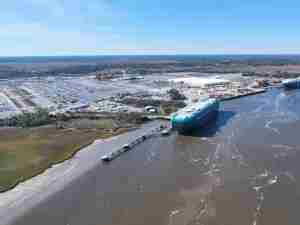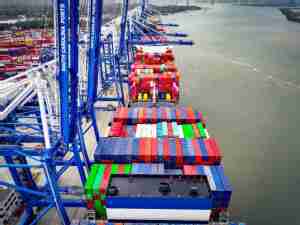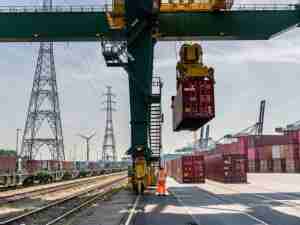Mobile harbor crane from Terex Port Solutions supports aid work in the crisis region around Tacloban
posted by AJOT | Dec 05 2013 at 12:12 PM | Ports & Terminals
A Terex® Gottwald Model 3 mobile harbour crane from Terex Port Solutions (TPS) will support aid work in the city of Tacloban in the Philippines, which was almost completely destroyed by typhoon Haiyan at the beginning of November. The crane, a G HMK 3405 crane variant with a maximum lifting capacity of 100 t, will be used locally, for unloading containers with aid consignments of all kinds and other activities to support the population of the province Leyte and its capital Tacloban.
The Terex Gottwald mobile harbour crane provides the technological backbone for a concerted relief effort in which TPS, its Manila-based customer International Container Services Inc. (ICTSI), and Hamburg shipping firm SAL-Heavylift GmbH (SAL) are each playing major roles. In addition, Stinis NV from the Netherlands brought two spreaders to Tacloban to help unload containers.
Diverted to crisis region following request by the Philippines authorities
The Terex Gottwald Model 3 crane, which was successfully unloaded on to the undamaged quay in Tacloban by the on-board cranes of the SAL heavy load vessel “MV Gloria”, was originally on its way to Davao further to the south. There, together with another identical crane on board, the mobile harbour crane was due to start work in the terminal of Hijo International Port Services Inc. (HIPS), a joint venture of ICTSI and Hijo Resources Corp. (HRC). As Klaus Peter Hoffmann, Vice President & Managing Director Terex Port Solutions, explains: “The MV Gloria was already just off Davao, when ICTSI contacted TPS with a request to change course immediately for Tacloban, where a crane was urgently needed.” The Philippine authorities made a corresponding request to ICTSI, the leading terminal operator in the country. “TPS, together with ICTSI and SAL, immediately undertook measures to redirect the crane to the disaster zone,” said Hoffmann
Continuous communication provides quick aid
However, before the G HMK 3405 crane could be successfully unloaded in Tacloban, the ship, crewed entirely by citizens of the Philippines, first returned to Davao to unload the second crane. Finally, halfway between Davao and Tacloban, a generator was unloaded. These two unloading maneuvers were necessary because, fully laden, the draught of the MV Gloria was too deep to dock at Tacloban. The fact that, in spite of the circumstances, everything was quickly resolved, explains Hoffmann, was the result of continuous communication between all the partners involved and their shared determination to help the victims of the typhoon: “It is clear that, in such an emergency situation, no thought is given to the costs, but solely to the needs of the people, so we did not hesitate and, in line with the citizenship values set out in the ‘Terex Way’, we immediately rose to the occasion.”
Assignment in Tacloban until a long-term functional infrastructure is established
Since the fully assembled G HMK 3405 mobile harbour crane operates without a rail infrastructure, the commissioning is already underway and the urgently needed cargo handling work will start soon in Tacloban. The crane will remain in the crisis region indefinitely to assist with delivery of urgently needed relief supplies. ICTSI will run the Tacloban port free, and will continue to do so up until the close of the government’s relief operations and normal transportation network has been restored.










